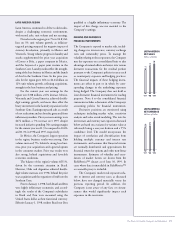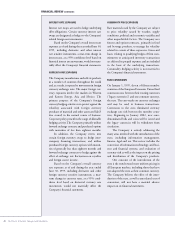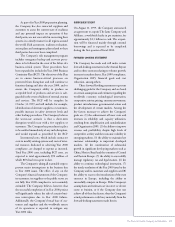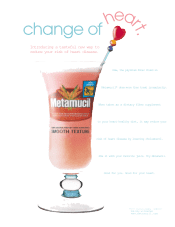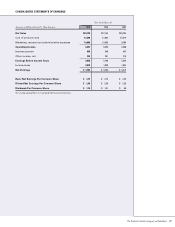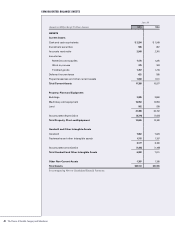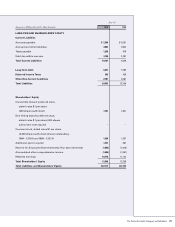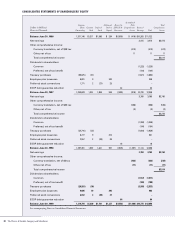Proctor and Gamble 1999 Annual Report Download - page 24
Download and view the complete annual report
Please find page 24 of the 1999 Proctor and Gamble annual report below. You can navigate through the pages in the report by either clicking on the pages listed below, or by using the keyword search tool below to find specific information within the annual report.
FINANCIAL REVIEW (CONTINUED)
20
The Procter & Gamble Company and Subsidiaries
INTEREST RATE EXPOSURE
Interest rate swaps are used to hedge underlying
debt obligations. Certain currency interest rate
swaps are designated as hedges to the Company’s
related foreign net investments.
Based on the Company’s overall interest rate
exposure as of and during the year ended June 30,
1999, including derivative and other interest
rate sensitive instruments, a near-term change in
interest rates, at a 95% confidence level based on
historical interest rate movements, would not mate-
rially affect the Company’s financial statements.
CURRENCY RATE EXPOSURE
The Company manufactures and sells its products
in a number of countries throughout the world
and, as a result, is exposed to movements in foreign
currency exchange rates. The major foreign cur-
rency exposures involve the markets in Western
and Eastern Europe, Asia and Mexico. The
primary purpose of the Company’s foreign
currency hedging activities is to protect against the
volatility associated with foreign currency
purchases of materials and other assets and liabil-
ities created in the normal course of business.
Corporate policy prescribes the range of allowable
hedging activity. The Company primarily utilizes
forward exchange contracts and purchased options
with maturities of less than eighteen months.
In addition, the Company enters into
certain foreign currency swaps to hedge inter-
company financing transactions, and utilizes
purchased foreign currency options with maturi-
ties of generally less than eighteen months and
forward exchange contracts to hedge against the
effect of exchange rate fluctuations on royalties
and foreign source income.
Based on the Company’s overall currency
rate exposure as of and during the year ended
June 30, 1999, including derivative and other
foreign currency sensitive instruments, a near-
term change in currency rates, at a 95% confi-
dence level based on historical currency rate
movements, would not materially affect the
Company’s financial statements.
COMMODITY PRICE EXPOSURE
Raw materials used by the Company are subject
to price volatility caused by weather, supply
conditions, political and economic variables and
other unpredictable factors. The Company uses
futures and options contracts, primarily in food
and beverage products, to manage the volatility
related to certain of these exposures. Gains and
losses relating to qualifying hedges of firm com-
mitments or anticipated inventory transactions
are deferred in prepaid expenses and are included
in the basis of the underlying transactions.
Commodity hedging activity is not material to
the Company’s financial statements.
EURO CONVERSION
On January 1, 1999, eleven of fifteen member
countries of the European Economic Union fixed
conversion rates between their existing currencies
(“legacy currencies”) and one common currency,
the euro. The euro trades on currency exchanges
and may be used in business transactions.
Conversion to the euro eliminated currency
exchange rate risk between the member coun-
tries. Beginning in January 2002, new euro-
denominated bills and coins will be issued and
the legacy currencies will be withdrawn from
circulation.
The Company is actively addressing the
many areas involved with the introduction of the
euro, including information management,
finance, legal and tax. This review includes the
conversion of information technology, and busi-
ness and financial systems, and evaluation of
currency risk as well as the impact on the pricing
and distribution of the Company’s products.
One outcome of the introduction of the
euro is the trend toward more uniform pricing in
all European markets, including those that have
not adopted the euro as their common currency.
The Company believes the effect of the intro-
duction of the euro, as well as any related cost of
conversion, will not have a material adverse
impact on its financial statements.











